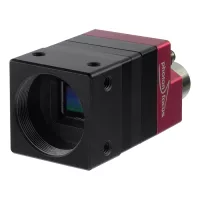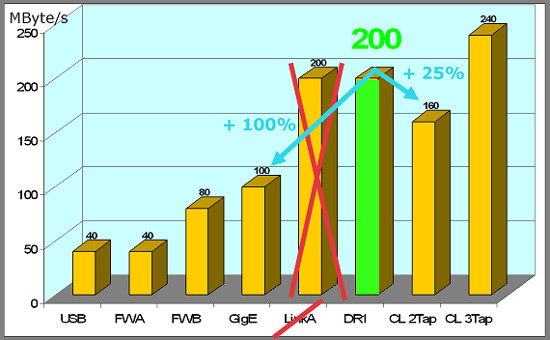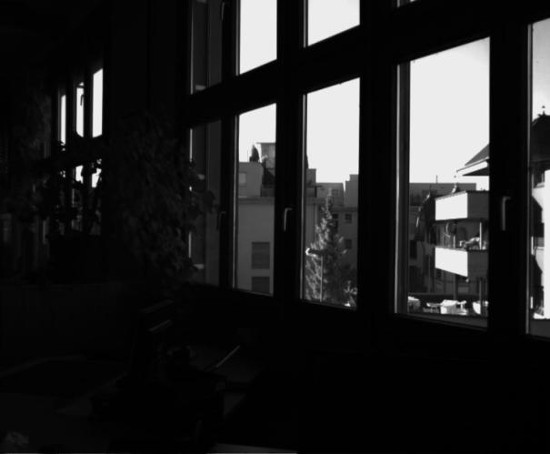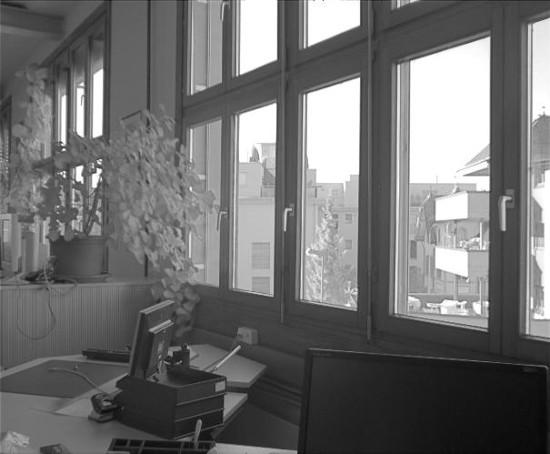Photonfocus DR0-D1920-S01-480-G2 Alternatives & Competitors
Ranked Nr. 163 of 126 2D Vision Systems

Top 10 DR0-D1920-S01-480-G2 Alternatives
- Photonfocus MV2-D2448-S01-G1
- Photonfocus MV2-D2448-S01-G1
- Photonfocus DR1-D1312-200-G2
- Photonfocus MV0-D1280-O01-144-G2
- Photonfocus OEM0-D1984-O01-144-G2
- Photonfocus MV0-D2592-O01-144-G2
- Photonfocus MV0-D2048-C01-160-G2
- Photonfocus MV1-D1280-120-CL
- Photonfocus HD1-D1312-80-G2
- The Imaging Source DMK 33GX249e
- The Imaging Source DMK 33GX226

Photonfocus MV2-D2448-S01-G1
MonochromeThe camera series MV2-D2448-S01-G1 is based on the SONY IMX250 CMOS image sensor. The IMX250 CMOS image sensor is optimized for low light conditions and is available as standard monochrome version. The camera has the GigE interface (GigEVision).
These cameras focus on demanding applications in industrial image processing. They are optimized for low light applications. Due to the global shutter, even high-speed applications with exposure times in the µs-area are possible.
FEATURES:
- Configurable region of interest (ROI)
- Up to 8 regions of interest (MROI)
- Decimation in y-direction
- 2 look-up tables (12-to-8Bit) on user-defined image region (Region-LUT)
- Constant frame rate independent of exposure time
- Crosshairs overlay on the image
- Temperature monitoring of camera
- Camera informations readable over SDK
- Ultra low trigger delay and low trigger jitter
- Extended trigger input and strobe output functionality
- Status line in picture

Photonfocus MV2-D2448-S01-G1
MonochromeThe camera series MV2-D2448-S01-G1 is based on the SONY IMX250 CMOS image sensor. The IMX250 CMOS image sensor is optimized for low light conditions and is available as standard monochrome version. The camera has the GigE interface (GigEVision).
These cameras focus on demanding applications in industrial image processing. They are optimized for low light applications. Due to the global shutter, even high-speed applications with exposure times in the µs-area are possible.
FEATURES:
- Configurable region of interest (ROI)
- Up to 8 regions of interest (MROI)
- Decimation in y-direction
- 2 look-up tables (12-to-8Bit) on user-defined image region (Region-LUT)
- Constant frame rate independent of exposure time
- Crosshairs overlay on the image
- Temperature monitoring of camera
- Camera informations readable over SDK
- Ultra low trigger delay and low trigger jitter
- Extended trigger input and strobe output functionality
- Status line in picture

Photonfocus DR1-D1312-200-G2
Monochrome | Near-infraredThe Double Rate camera series DR1-D1312(IE)-200-G2 is based on the Photonfocus A1312 and A1312IE CMOS image sensors with LinLog® technology. The Double-Rate cameras are nearly 100% faster than standard GigE cameras and use only one data cable (no link-aggregation). The Photonfocus A1312 CMOS sensors with a full well capacity (FWC) of 90 ke- are optimized for high dynamic range applications and a high signal-to-noise ratio (SNR). The cameras have the GigE interface (GigEVision).
| Resolution | Frame rate [fps] |
| 1312 x 1082 | 135 |
| 1024 x 1024 | 180 |
| 800 x 600 | 385 |
| 640 x 480 | 585 |
| 544 x 512 | 636 |
Due to their excellent capabilities of managing high frame rates CMOS cameras are at the fore front of high speed image capturing and image analysis. Until recently CMOS high speed cameras were used as compact camera heads with an internal image buffer or as landed camera heads with a CameraLink full interface and frame grabbers with a large image buffer.
Applications such as motion analysis (e.g. in the area of bionic, sports or biomechanical analysis) and process failure analysis (e.g. burst or fracture of tools, failure of handling systems, breakdown of packaging systems) require frame rates which are increasingly being provided by fast CMOS standard cameras. These are also used in machine vision applications. The preferred camera choice for such applications are standard machine vision cameras with a GigE interface due to their flexibility in long transmission distance. For even faster motion analysis cameras with a double frame rate, being captured with a GigE interface and a combined link aggregation with recording systems are required.
Photonfocus has recognized the need and requirements of these applications. Their double rate (DR) camera technology displays a double bandwidth for data transmission via the standardized GigE Vision interface, common for machine vision applications. The technology is based on the standard software protocol GeniCam. This Photonfocus technology is based on standard bandwidth tools and standard software libraries used for high speed image capturing. Even a multiple camera system set-up can be easily implemented due to the usage of the GigE standard, in contrary to a point-to-point connection as used in Link aggregation solutions. With the GigE standard the data transmission is not getting interrupted.

Comparison of data rates of different interfaces used in machine vision
For this applications Photonfocus has developed the Double Rate (DR) camera technology which is setup on the standard implementation of the GigE interface and standard software protocols as GigEVision and GenICam. In the result high speed applications could be realized with standard tools and libraries. The setup of multi camera systems is easy and is not disabled as with link aggregation.
The Double Rate technology overcome the draw backs of link aggregation and enables frame rates of 585fps @ VGA resolution and 204fps @ 960 x 960 pixel. The Double-Rate camera DR1-D1312-200-G2-8 is 25% faster than standard Cameralink Base cameras and 100% faster than standard GigE cameras.
FEATURES:
- Double Rate technology
- Configurable region of interest (ROI)
- Up to 512 regions of interest (MROI)
- Decimation in y-direction
- Image correction
- 2 look-up tables (12-to-8Bit) on user-defined image region (Region-LUT)
- Constant frame rate independent of exposure time
- Crosshairs overlay on the image
- 3x3 convolver for image preprocessing
- Temperature monitoring of sensor and camera
- Ultra low trigger delay and low trigger jitter
- Extended trigger input and strobe output functionality

Photonfocus MV0-D1280-O01-144-G2
Monochrome | Near-infraredThe camera series MV0-D1280(I)-O01-144-G2 is based on the ON Semiconductor PYTHON1300 CMOS image sensor. The PYTHON1300 CMOS image sensors are optimized for low light conditions and are available as standard monochrome and as NIR (I) version. The cameras have the GigE interface (GigEVision).
These cameras focus on demanding applications in industrial image processing. They are optimized for low light applications. Due to the global shutter, even high-speed applications with exposure times in the µs-area are possible.
FEATURES:
- Configurable region of interest (ROI)
- Up to 8 regions of interest (MROI)
- Decimation in y-direction
- 2 look-up tables (12-to-8Bit) on user-defined image region (Region-LUT)
- Constant frame rate independent of exposure time
- Crosshairs overlay on the image
- Temperature monitoring of camera
- Camera informations readable over SDK
- Ultra low trigger delay and low trigger jitter
- Extended trigger input and strobe output functionality
- Status line in picture

Photonfocus OEM0-D1984-O01-144-G2
Monochrome | Near-infraredThe camera series OEM0-D1984(I)-O01-144-G2 is based on the ON Semiconductor PYTHON2000 CMOS image sensor. The PYTHON2000 CMOS image sensors are optimized for low light conditions and are available as standard monochrome and as NIR version. The cameras have the GigE interface (GigEVision).
These cameras focus on demanding applications in industrial image processing. They are optimized for low light applications. Due to the global shutter, even high-speed applications with exposure times in the µs-area are possible.
FEATURES:
- Configurable region of interest (ROI)
- Up to 8 regions of interest (MROI)
- Decimation in y-direction
- 2 look-up tables (12-to-8Bit) on user-defined image region (Region-LUT)
- Constant frame rate independent of exposure time
- Crosshairs overlay on the image
- Temperature monitoring of camera
- Camera informations readable over SDK
- Ultra low trigger delay and low trigger jitter
- Extended trigger input and strobe output functionality
- Status line in picture

Photonfocus MV0-D2592-O01-144-G2
Monochrome | Near-infraredThe camera series MV0-D2592(I)-O01-144-G2 is based on the ON Semiconductor PYTHON5000 CMOS image sensor. The PYTHON5000 CMOS image sensors are optimized for low light conditions and are available as standard monochrome and as NIR (I) version. The cameras have the GigE interface (GigEVision).
These cameras focus on demanding applications in industrial image processing. They are optimized for low light applications. Due to the global shutter, even high-speed applications with exposure times in the µs-area are possible.
FEATURES:
- Configurable region of interest (ROI)
- Up to 8 regions of interest (MROI)
- Decimation in y-direction
- 2 look-up tables (12-to-8Bit) on user-defined image region (Region-LUT)
- Constant frame rate independent of exposure time
- Crosshairs overlay on the image
- Temperature monitoring of camera
- Camera informations readable over SDK
- Ultra low trigger delay and low trigger jitter
- Extended trigger input and strobe output functionality
- Status line in picture

Photonfocus MV0-D2048-C01-160-G2
Monochrome | Near-infraredThe camera series MV0-D2048(I)-C01-160-G2 is based on the CMOSIS CMV4000 V3 CMOS image sensor. The CMV4000 V3 CMOS image sensors are optimized for low light conditions and are available as standard monochrome and as NIR (I) version. The cameras have the GigE interface (GigEVision).
These cameras focus on demanding applications in industrial image processing. They are optimized for low light applications. Due to the global shutter, even high-speed applications with exposure times in the µs-area are possible.
FEATURES:
- Configurable region of interest (ROI)
- Up to 8 regions of interest (MROI)
- Decimation in y-direction
- 2 look-up tables (12-to-8Bit) on user-defined image region (Region-LUT)
- Constant frame rate independent of exposure time
- Crosshairs overlay on the image
- Temperature monitoring of camera
- Camera informations readable over SDK
- Ultra low trigger delay and low trigger jitter
- Extended trigger input and strobe output functionality
- Status line in picture

Photonfocus MV1-D1280-120-CL
Monochrome | ColorThe camera series MV1-D1280(C)-120-CL is based on the e2v EV76C560 CMOS image sensor. The e2v EV76C560 CMOS image sensors are optimized for low light conditions and are available as standard monochrome and colour (C) version. The cameras have the CameraLink Base interface.
These cameras focus on demanding applications in industrial image processing. They are optimized for low light applications. Due to the global shutter, even high-speed applications with exposure times in the µs-area are possible.
FEATURES:
- Configurable region of interest (ROI)
- Decimation in x- and y-direction
- 2 look-up tables (12-to-8Bit) on user-defined image region (Region-LUT)
- Constant frame rate independent of exposure time
- Crosshairs overlay on the image
- Temperature monitoring of camera
- Camera informations readable over SDK
- Ultra low trigger delay and low trigger jitter
- Extended trigger input and strobe output functionality
- Status line in picture

Photonfocus HD1-D1312-80-G2
MonochromeThe camera series HD1-D1312-80-G2 is based on the Photonfocus A1312 CMOS image sensor with LinLog® technology. This Photonfocus CMOS sensor with a full well capacity (FWC) of 90 ke- is optimized for high dynamic range applications and a high signal-to-noise ratio (SNR). The sensor A1312 has an additional feature to widen the dynamic range. It is possible to expose the odd and even lines independently and choose also a independent sensor response curve. This enables different LinLog® settings for each field. The cameras have the GigE interface (GigEVision).
The high dynamic range camera series HD1-D1312 is a result of the demand for high dynamic range (HDR) images with linear response curve. The camera benefits from the odd/even exposure feature of the Photonfocus CMOS sensor A1312. This feature allows operating odd and even rows of the image sensor independently. In consequence the exposure time and the response curve of both fields could be setup independently. This enables a lot of applications which are well described in the literature.
The following pictures show an example for an interpolation and display with the help of a tone mapping algorithm. The exposure time of the even field was approximately 10 times longer than the exposure time of the odd field. The response curve in each field was linear.

Even field with long exposure time

Odd field with short exposure time

Interpolated HDR image dispayed with tone mapping
FEATURES:
- Odd/even HDR mode
- Configurable region of interest (ROI)
- Up to 512 regions of interest (MROI)
- Decimation in y-direction
- Image correction
- 2 look-up tables (12-to-8Bit) on user-defined image region (Region-LUT)
- Constant frame rate independent of exposure time
- Crosshairs overlay on the image
- 3x3 convolver for image preprocessing
- Temperature monitoring of sensor and camera
- Camera informations readable over SDK
- Ultra low trigger delay and low trigger jitter
- Extended trigger input and strobe output functionality
- Status line in picture

The Imaging Source DMK 33GX249e
Monochrome1/1.2 inch Sony CMOS Pregius sensor (IMX249)
1,920×1,200 (2.3 MP), up to 48 fps
Global shutter
Trigger and I/O inputs
Manufactured by The Imaging Source
Windows and Linux software included

